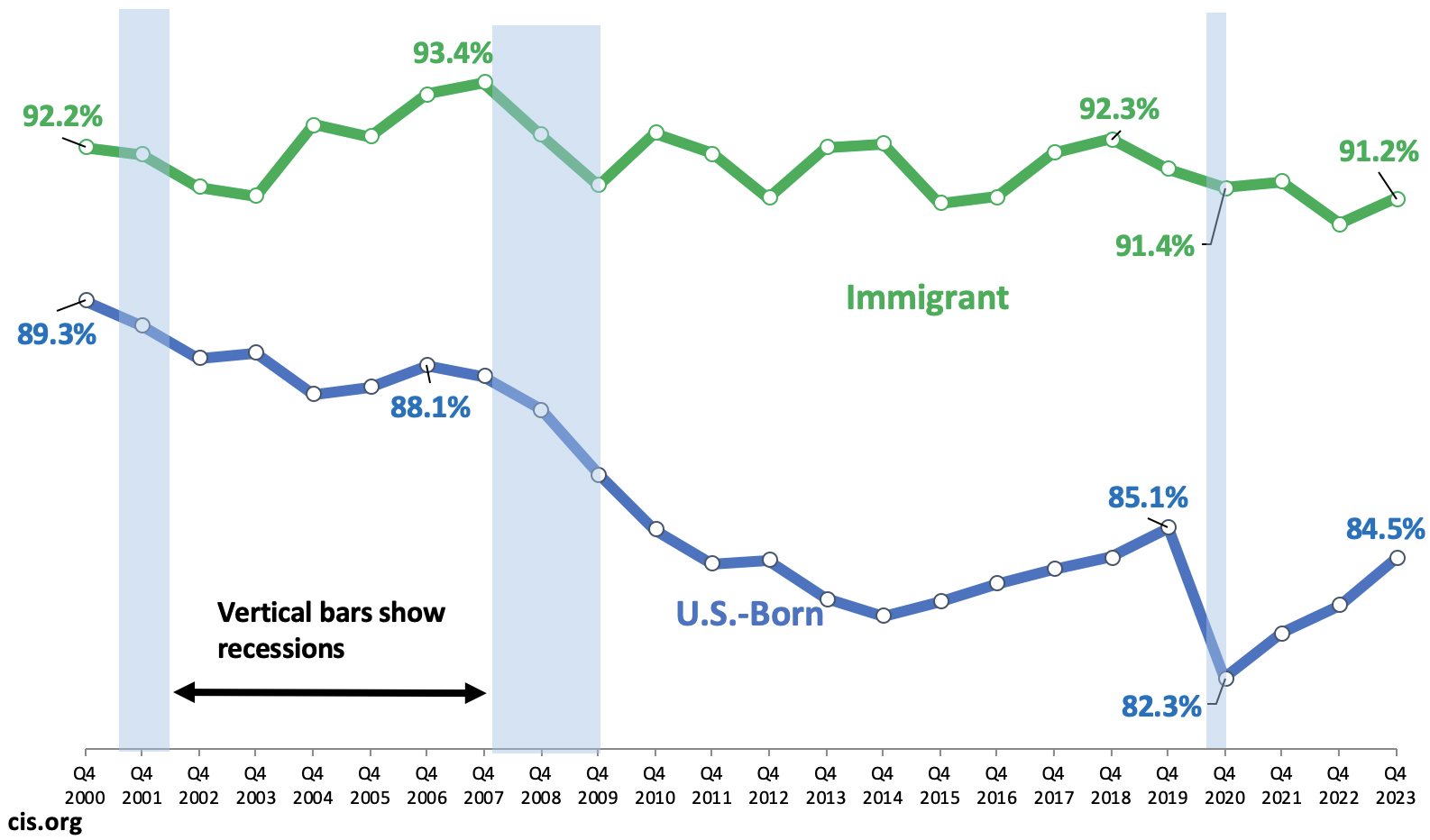
[ad_1]
The Chamber of Commerce has its steady of high-immigration speaking factors — telling us, for instance, that the official unemployment fee is low, that immigrants are “filling gaps” and boosting GDP, and that imposing immigration legislation can be “draconian”.
This week, nonetheless, the purveyor of those self same tropes is the Financial Coverage Institute, a labor-oriented assume tank whose students as soon as had a extra nuanced view of immigration and its influence on staff and the nation. We stay in unusual political instances, when it appears that evidently practically everybody on the left endorses excessive immigration with out a trace of reservation. In any case, the EPI put up, written by Daniel Costa and Heidi Shierholz, criticizes my latest report evaluating immigrant and native job progress, so I need to make a number of factors in response.
First, Costa and Shierholz’s assertion that immigration has no influence on labor market outcomes for U.S.-born staff is solely incorrect. The 2017 Nationwide Academies of Sciences, Engineering, and Drugs research of immigration lists quite a few research displaying detrimental wage impacts, particularly on the less-educated. A 2019 overview of over 50 research by Anthony Edo within the Journal of Financial Surveys involves related conclusions. However we’d like not rely solely on teachers. Enterprise teams just like the Chamber of Commerce have brazenly pushed for extra immigration with a purpose to sluggish the inflation supposedly attributable to excessive wages. The truth is, inflation has led immigration advocates over the past couple of years to argue not solely that immigration holds down wages, however it’s good that it does!
Second, the EPI authors’ argument that the labor pressure participation fee for “prime-age” U.S.-born males (25 to 54) has improved for the reason that low of 2020 shouldn’t be reassuring. The determine under comes straight from our latest employment report and reveals the labor pressure participation of prime-age U.S.-born males. The speed for these males has definitely improved for the reason that depths of Covid, however it stays under the extent of 2019 and is nicely under the prior peaks in 2006 and 2000. The truth is, participation has been declining for these males going again to 1960, when greater than 90 % had been within the labor pressure. The latest will increase, whereas encouraging, on no account to repair this very longstanding drawback.
Labor Drive Participation for Immigrants and U.S.-Born Males (Ages 25 to 54) With out a Bachelor’s Diploma, 2000 to 2023 |
 |
|
Supply: Heart for Immigration Research evaluation of the Present Inhabitants Survey public-use information for yearly from the fourth quarter of 2000 to the fourth quarter of 2023. All figures are seasonally unadjusted and are for non-institutionalized civilians, which doesn’t embrace these in establishments reminiscent of prisons and nursing houses. “Immigrant” matches the Census Bureau’s definition of “foreign-born” and contains all individuals who weren’t U.S. residents at beginning. These within the labor pressure are working or searching for work. Determine excludes all these with a bachelor’s diploma or increased. |
Equally vital, to argue that immigration can scale back labor pressure participation or wages of natives shouldn’t be the identical as saying it’s the solely issue that ever issues, or that issues can by no means enhance for staff throughout a interval of excessive immigration. To recommend, as Costa and Shierholz do, that the latest enchancment in labor pressure participation for less-educated males means immigration has no influence on these staff is not sensible. Furthermore, their assertion that the rise in labor pressure participation amongst less-educated males is “beating expectations” is persuasive provided that one has very low expectations.
Third, is whether or not concern about immigration is mostly a “distraction from dynamics which are really hurting working folks”, reminiscent of weak labor requirements and unions, as Costa and Shierholz allege. These “dynamics”, they write, have put “an excessive amount of energy within the fingers of firms and employers”. However rising the provision of staff by immigration is precisely a kind of dynamics. Why the actual dynamic of immigration now not issues the EPI authors shouldn’t be clear, particularly when one considers the historical past of the labor motion.
Because the late Vernon Briggs, a robust supporter of unions, argued in his ebook, Immigration and American Unionism, “Unions thrive (membership grows) when immigration is low or ranges are contracting; unions falter (membership declines) in periods when immigration is excessive or ranges are rising.” Briggs provides that union leaders for many of American historical past “intuitively believed this to be the case and acted accordingly”. Costa and Shierholz would do nicely to think about what labor leaders knew in a long time previous: Immigration is usually not within the pursuits of American staff. To make certain, immigration is certainly not the one subject confronting American staff, however it shouldn’t be dismissed as a “distraction” when all the proof signifies in any other case.
[ad_2]